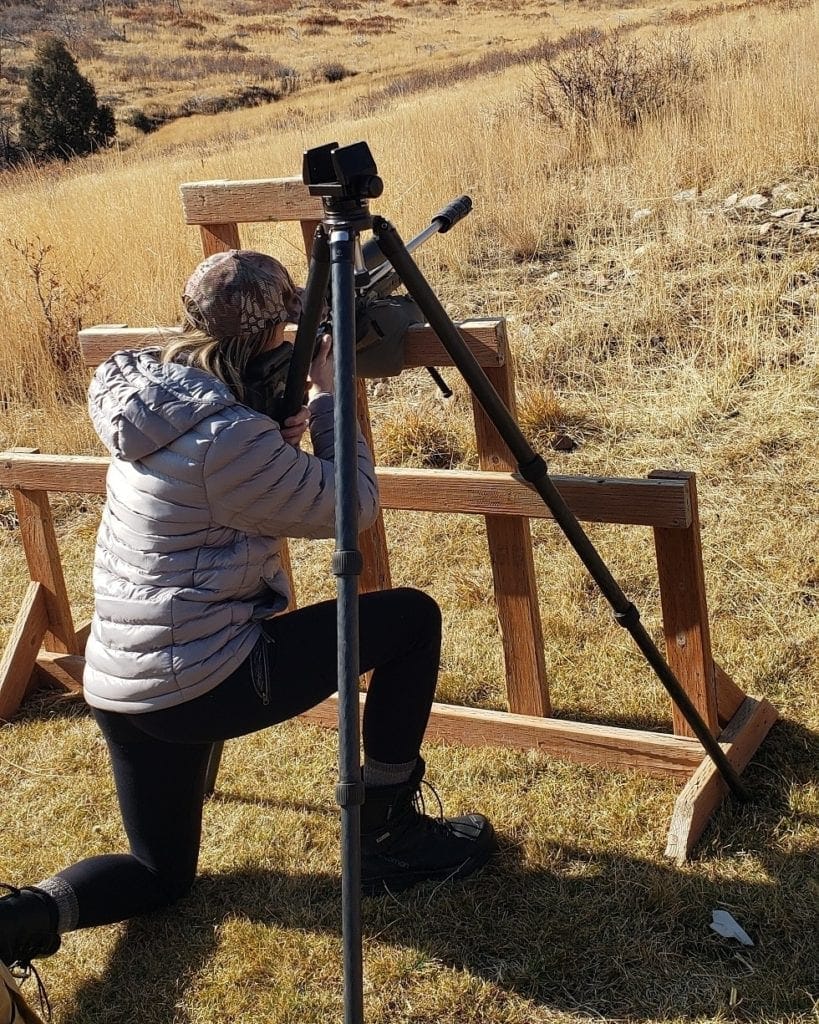If you are like me, you are already dreaming of big game and the chance at a killer shot. I mostly hunt archery for deer and elk, but I had the incredible opportunity to train and learn from a Precision Rifle Series Match Director on long-range shooting skills. I am here to share the tips and tricks I learned from Mr. Austin Overman.

While living in Georgia, the longest shot I ever had to make on an animal was around 50 yards. Because we had tree stands or blinds set up, shooting lanes were prepped in the woods to make sure that we had a great opportunity for a vital shot. Now that I live in Utah, I had to completely rewire myself to pack an entire day of food and clothes along with carrying my rifle for miles of a mountain climb.
{Read: Tips for Shooting a Shotgun}
Hunting in the West is a dream for many, but it comes with an entirely complex set of parameters for getting it done. You need to be able to cover the terrain and find the animals. You need to be able to KNOW your backstop long before you set up. Lastly, you need to be very capable of making a solid shot on your animal.
Long-Range Shooting Fundamentals
Here is a simple list of long-range shooting fundamentals that I learned and work great for me. On my very first day out shooting with Austin Overman, I was able to hit targets ranging from 100 yards to 1,340 yards! It was a moment that I will never forget. It took days for my smile to stop being permanent. My cheeks were sore for days!
Position your body completely behind the rifle and the optics.
Many shooters stand to the side of their rifle stock and cram it into their armpit. They then have to lean over the stock and crane their head to look into their scope. This frequently leads to not seeing correctly down the optic. If you consider the scope as a paper towel tube, you want to see perfectly straight down the tube. If you are leaning a little with your face offset, then it does alter your visual and make a shot that won’t be placed where you want it. Try to see a perfect circle through your scope. If you have edges from your scope frame, then you are not centered usually.
Don't grip with your thumb wrapped around the stock when long-range shooting.
I learned that I was death gripping my stock and it created differences in my shots. I began holding my thumb on the side of the stock near my fingers to not grasp or twist the entire frame of the rifle itself. This is supremely similar to a proper grip on a bow. Any bow hand tension or torque will make an arrow not hit where you aim.
If you are prone, which is best for stability, then use your non-dominant hand to help support a sandbag or rifle rest.
This keeps you from holding the stock of the rifle itself and creating more movement as you breathe. Make sure to lean into the butt of the rifle for stability instead of trying to pull it to your body. This makes every shot much more consistent and able to replicate. If you prefer to hold your non-dominant hand forward on the rifle, then gently drape your hand over the top of the scope for stability. Just be cautious not to apply any pull or force that may alter the shot.
Keep your breathing slow and steady.
Try your best not to hold your breath. Take the shot on the pause in your breath as you shift from the exhale to the next inhale. This will keep you from having the butt of the rifle moving because your chest expands during an inhale, and it will lift the back end of the rifle. Shooting on the pause with a slow and steady pull of the trigger gives you the most reproducible and predictable result.
{Read It Now: High Power Shooting: 5 Things I Learned}
This does not get into the wind and many other considerations for long-range shots, but this is the basic breakdown of how to get the best shot every time, no matter the yardage. It is important to test yourself on the range to know your shot limits before you have an animal in your crosshairs. Please do not try for a 500-yard shot when you have only practiced at 50 to 100 yards. You must know how your shots perform at any distance you will shoot. I try and practice to 1,000 yards, but honestly do not feel that I would hunt over 500 to 600 yards until I get much more work under my belt.
Want more tips for long-range shooting?
Understand the Basics of Ballistics.
Before you can master long-range shooting, it's important to understand the basics of ballistics. This includes understanding how bullets travel through the air, how wind and other environmental factors can affect their trajectory, and how to adjust your aim accordingly. By mastering the basics of ballistics, you'll be better equipped to hit your targets from a distance and improve your overall accuracy.
Choose the Right Rifle and Optics.
When it comes to long-range shooting, choosing the right rifle and optics is crucial. Look for a rifle that is specifically designed for long-range shooting, with a heavy barrel and a high-quality trigger. As for optics, a high-powered scope with adjustable magnification and a large objective lens is essential. Make sure to invest in quality equipment that will last and help you achieve your shooting goals.
Practice Proper Shooting Techniques.
Proper shooting techniques are essential for mastering long-range shooting. Start by establishing a stable shooting position, with your feet shoulder-width apart and your body aligned with the target. Use a shooting rest or bipod to support the rifle and minimize movement. Focus on your breathing, taking slow, deep breaths and pausing briefly between each one. Finally, squeeze the trigger gently and smoothly, without jerking or flinching. With practice, these techniques will become second nature and help you achieve greater accuracy at long distances.
Learn to Read Wind and Weather Conditions.
One of the biggest challenges in long-range shooting is accounting for wind and weather conditions. Wind can cause bullets to drift off course, while changes in temperature and humidity can affect bullet velocity and trajectory. To master long-range shooting, it's important to learn how to read wind and weather conditions and adjust your aim accordingly. Use a wind meter to measure wind speed and direction, and pay attention to other environmental factors like the angle of the sun and the presence of obstacles like trees or buildings. With practice, you'll be able to make more accurate shots even in challenging conditions.
Develop a Consistent Routine and Practice Regularly.
To truly master long-range shooting, it's important to develop a consistent routine and practice regularly. This means setting aside dedicated time for shooting practice, and sticking to a schedule even when it's inconvenient or difficult. It also means focusing on the fundamentals of shooting, like proper stance, grip, and trigger control, and working on these skills until they become second nature. By developing a consistent routine and practicing regularly, you'll build muscle memory and improve your accuracy over time.
